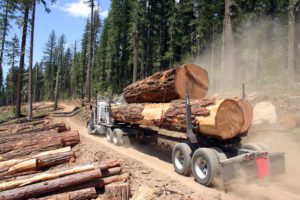Whether you’ve purchased a new property or you’re planning to mark timber harvest property lines, you must understand where your boundary lines lie. Perhaps you want to build a stone wall along your property boundary, or use bits of barbed wire or iron posts to indicate boundaries to avoid future disputes with a neighbor? In any case, identifying your boundary line is important.
Especially if you’re based in Maine, you need to be extra vigilant about marking timber harvest property lines on your property because any miscalculation can lead to grave repercussions. The first step to planning a successful timber harvest is to make sure you have clearly identified your boundary lines.
 Prohibitions on Timber Harvesting On other’s Land
Prohibitions on Timber Harvesting On other’s Land
In Maine Law, an established timber harvest property line refers to any line demarcated by pins, monuments, markings, reference points, signs, or other identifiers to denote ownership between properties.
These markers should be placed based on historical evidence or through a licensed professional surveyor, and both parties should mutually agree to it. The law prohibits harvesting timber on someone else’s property line.
For instance, if a landowner representative or a landowner authorizes timber harvest should do so after clearly identifying the boundary line using flagging or visible markers. Property line marking should be completed before timber harvest, and in case of non-compliance, the landowner is subject to a fine under civil violation.
Importance of Boundary Lines
Whether you’re in Maine or not, identifying your timber harvest property lines is important before commencing the harvest. Here’s why you should do it:
Compliance With Law
The first reason to identify boundary lines of your property is to ensure that you comply with the law. As we’ve mentioned above, marking needs to be visible and should be done before the harvest. Similarly, you need to obtain the permission of the abutting landowner before starting timber harvest. Thus, you avoid fines and civil litigation by identifying and marking your boundary lines.
Avoid Monetary Losses
When you violate a forestry law, you’re required to pay the damages. Damages such as fines and penalties are part of the civil litigation process in Maine. This means paying a fine of $250 to $1000. If you don’t hire a professional surveyor or look up resources to find your property lines, you could lose money on fines.
Lawsuit By Neighbor
Sometimes, your neighbors may sue you for marking the boundary line without a mutual agreement. The best way to avoid any dispute and rift is to work with your neighbor. You can draft a contract and mutually agree to it. A land surveyor will help you determine where your property begins and ends so you can mark the corners and use it for harvest.
Where Will You Find Required Information?
If you’re unsure where to find the information about your timber harvest property lines, you can find boundary monuments or property markers yourself. If the property has been surveyed in the past, you’ll find the stakes or metal pins at each corner. These markers will be on the land survey as well.
If you don’t know how to find property markers, visit your state or regional website to find the relevant information. Land survey documents are available at your county’s clerk’s office. These documents have thorough information about property boundaries. However, the information can be complex and hard to understand. You can hire a surveyor to decipher the meaning for you.
Aside from looking up the information yourself, you can also hire a professional surveyor to do the job for you. A licensed surveyor has the knowledge and expertise to identify your timber harvest property line and place markers to demarcate your boundary.
What Happens If Your Neighbor Harvests Timber on Your Property?
If your neighbor harvests timber on your land, you have the right to act. Property lines are important, and any encroachment can result in problems. You can directly talk to your neighbor because it can be an honest mistake.
If the problem persists and your neighbor doesn’t cooperate, you can show the property deed and hire a professional. A surveyor will place new markers to resolve the issue, but if your neighbor continues to harvest timber or use your property for their personal goals, you can hire a lawyer to file a trespass lawsuit.
Do You Have More Questions Related to Timber Harvest Property Lines?
We at William A. Day Jr. & Sons can help you connect with the right personnel and guide you through the process. Identifying your timber harvest property lines before the harvest season is important. Once your land is surveyed, we can help you with timberland harvesting. Reach out to us today to consult on your property and timber harvesting process.
